|
|
|
Sort Order |
|
|
|
Items / Page
|
|
|
|
|
|
|
| Srl | Item |
| 1 |
ID:
144220
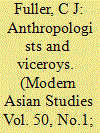

|
|
|
|
|
| Summary/Abstract |
The anthropology of caste was a pivotal part of colonial knowledge in British India in the late nineteenth and early twentieth centuries. Denzil Ibbetson and Herbert Risley, then the two leading official anthropologists, both made major contributions to the study of caste, which this article discusses. Ibbetson and Risley assumed high office in the imperial government in 1902 and played important roles in policy making during the partition of Bengal (1903–5) and the Morley-Minto legislative councils reforms (1906–9); Ibbetson was also influential in deciding Punjab land policy in the 1890s. Contemporary policy documents, which this article examines, show that the two men's anthropological knowledge had limited influence on their deliberations. Moreover, caste was irrelevant to their thinking about agrarian policy, the promotion of Muslim interests, and the urban, educated middle class, whose growing nationalism was challenging British rule. No ethnographic information was collected about this class, because the scope of anthropology was restricted to ‘traditional’ rural society. At the turn of the twentieth century, colonial anthropological knowledge, especially about caste, had little value for the imperial government confronting Indian nationalism, and was less critical in constituting the Indian colonial state than it previously had been.
|
|
|
|
|
|
|
|
|
|
|
|
|
|
|
|
| 2 |
ID:
144221


|
|
|
|
|
| Summary/Abstract |
Contrary to the long-standing idea of a scientific failure in early modern China as compared to Europe, some recent work has emphasized the existence of a tradition of ‘evidential’ research in the natural sciences, antiquarianism, and geography, especially during the Sung, Ming, and Qing periods. This article seeks to develop this new perspective by offering a comparative history of the genres of travel writing and ethnography in early modern Europe and Ming/early Qing China. We argue that there were qualitative as well as quantitative differences in the way that these genres functioned in each cultural area. Even when we find apparent similarities, we note different chronological rhythms and a different position of these genres of travel writing within a wider cultural field—what we might term their ‘cultural relevance’. The specific nature of Chinese state imperialism—or, conversely, the particular nature of European overseas colonialism—played a role in determining the type of ethnographic approach that came to predominate in each cultural area. These parallels and differences suggest a fresh perspective on the cultural origins of the ‘great divergence’.
|
|
|
|
|
|
|
|
|
|
|
|
|
|
|
|
| 3 |
ID:
144215


|
|
|
|
|
| Summary/Abstract |
In giving the very first lecture that first-year History of Art undergraduates at Oxford will hear, I usually employ the practice of giving them a sheet of paper with nothing on it but the outlines of the land masses of the globe, and ask them to draw a line round ‘the West’. The idea was inspired by a reading of Lewis and Wigen's 1997 book The Myth of Continents (‘justly celebrated’, as Sanjay Subrahmanyam says), and remains a useful pedagogic act, up to a point, for the reasons so clearly laid out in that book; also, it breaks the ice, it gets a buzz of conversation going in the room, it certainly foregrounds the topic, central now to art historical enquiry, of the way in which ‘representations are social facts’. But the reason I do not ask them to draw a map round ‘the East’ is that I suspect it would be too easy, or at least done too quickly, and indeed the boundaries of both ‘East’ and ‘Orient’, as ‘Europe's Other’, can be shown to have fluctuated much less than have the boundaries of what, for most Oxford students, is still, if somewhat tenuously, ‘us’ or ‘here’. Wherever ‘the East’ is, it all lies (as Subrahmanyam points out in his lecture) in that assuredly -etic part of the world called Asia. I might, in the privacy of my own hard drive, choose to categorize those European images which I need for teaching as ‘Non-Eastern’ (to balance the ‘Non-Western’ rubric on which my specialist options appear in the syllabus). But that is not a category widely used, or at least not in my own discipline of art history.
|
|
|
|
|
|
|
|
|
|
|
|
|
|
|
|
| 4 |
ID:
144222
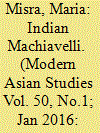

|
|
|
|
|
| Summary/Abstract |
This article explores the ways in which the Arthasastra (The Science of Wealth or The Science of Power), an ancient text rediscovered in 1905, was interpreted by Indian politicians and commentators. It seeks to explain why the text's popularity changed so drastically over time, and why, despite the excitement about it in the first 20 years following its reappearance, it was largely ignored in the Gandhian and Nehruvian eras, until a striking revival of interest from the late 1980s onwards. It argues that these changes in the text's fortunes can be explained partly as a result of significant shifts in elite Indian political culture. It also suggests that we need to reassess our analysis of the fundamental fault-lines in Indian politics, questioning Chatterjee's and Nandy's argument on the centrality of tensions between Gandhian ‘indigenous’ thought and Nehruvian ‘Western’ modernity, and arguing for the importance of the conflict between a moral politics, endorsed by both Gandhi and Nehru, and a ‘pragmatic’ politics justified by the Arthasastra.
|
|
|
|
|
|
|
|
|
|
|
|
|
|
|
|
| 5 |
ID:
144212
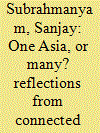

|
|
|
|
|
| Summary/Abstract |
In recent years people have been saying that the next century will be the century of Asia and the Pacific, as if that were sure to be the case. I disagree with this view. If we exclude the United States, the only countries in the Asia-Pacific region that are relatively developed are Japan, the ‘four little dragons’, Australia and New Zealand, with a total population of at most 200 million. (. . .) But the population of China and India adds up to 1.8 billion. Unless those two countries are developed, there will be no Asian century. No genuine Asia-Pacific century or Asian century can come until China, India and other neighbouring countries are developed. By the same token, there could be no Latin-American century without a developed Brazil. We should therefore regard the problem of development as one that concerns all mankind and study and solve it on that level. Only thus will we recognize that it is the responsibility not just of the developing countries but also of the developed countries.
|
|
|
|
|
|
|
|
|
|
|
|
|
|
|
|
| 6 |
ID:
144214


|
|
|
|
|
| Summary/Abstract |
It has been said that if completely known and understood, a historical phenomenon is therefore dead. Yet how perverse, so it might seem, that the scholarly revelation of the complex history of a powerful concept might therefore be taken as an argument that it should therefore be entirely abandoned. This is, of course, not Sanjay Subrahmanyam's conclusion about the notion of Asia. The choice he poses is not between one Asia or none, but between a singular and overarching universal and an unevenly connected plurality. However, further complementary questions might pose themselves. Under what conditions can this plurality and these connections become anything like objects of knowledge? And of whose knowledge? These are, perhaps, issues where historians of the sciences might contribute. It is a distressingly familiar theme among those historians that it has too often been supposed that a demonstration of the historical construction and variable functions of an object is to be understood somehow as a denial of that object's existence or value.
|
|
|
|
|
|
|
|
|
|
|
|
|
|
|
|
| 7 |
ID:
144218


|
|
|
|
|
| Summary/Abstract |
The Chinese Communist Party was confronted with the pressing challenge of ‘reconstructing’ China's industrial economy when it came to power in 1949. Drawing on recently declassified Chinese Foreign Ministry archives, this article argues that the Party met this challenge by drawing on the expertise of Japanese technicians left behind in Northeast China at the end of the Second World War. Between 1949 and 1953, when they were eventually repatriated, thousands of Japanese technicians were used by the Chinese Communist Party to develop new technology and industrial techniques, train less skilled Chinese workers, and rebuild factories, mines, railways, and other industrial sites in the Northeast. These first four years of the People's Republic of China represent an important moment of both continuity and change in China's history. Like the Chinese Nationalist government before them, the Chinese Communist Party continued to draw on the technological and industrial legacy of the Japanese empire in Asia to rebuild China's war-torn economy. But this four-year period was also a moment of profound change. As the Cold War erupted in Asia, the Chinese Communist Party began a long-term reconceptualization of how national power was intimately connected to technology and industrial capability, and viewed Japanese technicians as a vital element in the transformation of China into a modern and powerful nation.
|
|
|
|
|
|
|
|
|
|
|
|
|
|
|
|
| 8 |
ID:
144213
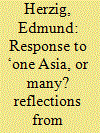

|
|
|
|
|
| Summary/Abstract |
The idea of Asia as a unity has appealed both to Europeans interested in differentiating themselves from a threatening, if inferior, Asiatic ‘other’, and to Asians keen to mark their distance from an alien and alienating Europe and West. For both groups, Asia is a useful term of alterity, although the place of ‘us’ and ‘them’ is reversed. Near the beginning of his lecture Sanjay Subrahmanyam remarks that, ‘in the play between the -emic and the -etic, the insider's and the outsider's perspective, a concept like “Asia” falls decidedly on the side of the -etic’. This point is reinforced by the fact that the European concept of Asia goes back to the Ancient Greeks (as Subrahmanyam notes), whereas the interest of Asian insiders in the concept of a homogeneous Asia is a modern phenomenon, a reaction against the assumption of superiority inherent in Western imperialism and neo-imperialism. In the case of both the European and the Asian conceptions, however, it is the viewpoint of the observer, rather than the empirical features of what is observed, that gives shape and meaning to the concept. I will use this short response to take a look at Asia from a third perspective, one that is neither fully ‘insider’ nor ‘outsider’ in character, namely that of the early modern Armenians, whose travels took them across the length and breadth of Asia, and Europe too.
|
|
|
|
|
|
|
|
|
|
|
|
|
|
|
|
| 9 |
ID:
144217
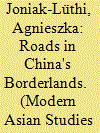

|
|
|
|
|
| Summary/Abstract |
Since the beginning of the twenty-first century, the tarmac road network in Xinjiang Uyghur Autonomous Region in northwest China has been greatly expanded. The total length of roads increased from about 30,000 kilometres in 1999 to more than 146,000 kilometres in 2008. Though roads are considered by the state to be instruments of economic development, in multi-ethnic border regions like Xinjiang, the role of an efficient road network in the construction of the Chinese state's imaginary ‘bounded space’ is arguably just as crucial. With the help of Lefebvre's (1991) and Soja's (1999) conceptualization of space, this article explores the multiple spatial figurations of which roads are a part in Xinjiang. The article starts from ‘the mappable’ dimension of the expanding road network, and moves on to discuss perceptions and representations related to this expansion, before finally discussing how individuals creatively explore its fissures and hidden pockets.
|
|
|
|
|
|
|
|
|
|
|
|
|
|
|
|
| 10 |
ID:
144223


|
|
|
|
|
| Summary/Abstract |
Scholars have long debated the impact of the British ‘rule of property’ on India. In our own day it has become common for historians to hold that the Raj's would-be regime of free capitalist property was frustrated by a pervasive divide between rhetoric and reality which derived from a fundamental lack of fit between English ideas and Indian land control practices. While seemingly novel, the contemporary emphasis on the theory-practice divide is rooted in an earlier ‘revisionist’ perspective among late-nineteenth-century colonial thinkers who argued that land control in the subcontinent derived from a uniquely Indian species of ‘proprietary’ (rather than genuinely propertied) right-holding. In this article, I critically examine the revisionist discourse of ‘proprietary right’ by situating it in a broader comparative perspective, both relative to earlier ideas about rendering property ‘absolute’ during the East India Company's rule and relative to the changing conception of the property right among legal thinkers in the central domains of the Anglo-common law world. In so doing, the article significantly revises our understanding of the relationship between property, law, and political economy in the subcontinent from the late eighteenth to the late nineteenth century.
|
|
|
|
|
|
|
|
|
|
|
|
|
|
|
|
| 11 |
ID:
144216


|
|
|
|
|
| Summary/Abstract |
In 1971 a war led to the creation of Bangladesh. Instantly three narratives sprang up: the war as a national triumph, the war as betrayal and shame, and the war as a glorious campaign. Today more layered interpretations are superseding these ‘first-generation narratives’. Taking the case of insurgents from neighbouring India who, against their will, became embroiled in the war, this article seeks to contribute to ‘second-generation narratives’ that challenge the historiographical apportioning of blame and the national/ethnic framing of the conflict. The article uses hitherto-unpublished photographs from private collections to demonstrate how the war for the liberation of Mizoram (India) and that for the liberation of Bangladesh became entangled. Jointly they produced a ‘war within a war’ that unsettles common assumptions about both these struggles.
|
|
|
|
|
|
|
|
|
|
|
|
|
|
|
|
| 12 |
ID:
144219


|
|
|
|
|
| Summary/Abstract |
This article argues that economic histories of the transition to colonial economics in the eighteenth century have overlooked the infrastructural investments that wives and widows made in networks of monastic commerce. Illustrative examples from late eighteenth-century records suggest that these networks competed with the commercial networks operated by private traders serving the English East India Company at the end of the eighteenth century. The latter prevailed. The results were the establishment of coverture and wardship laws interpellated from British common law courts into Company revenue policies, the demolition of buildings. and the relocation of the markets that were attached to many of the buildings women had sponsored. Together, these historical processes made women's commercial presence invisible to future scholars.
|
|
|
|
|
|
|
|
|
|
|
|
|
|
|
|
|
|
|
|
|